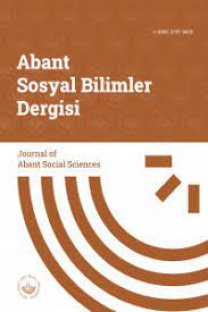EKONOMİK BÜYÜME VE NİTELİK UYARLANMIŞ BEŞERÎ SERMAYE İLİŞKİSİ: 1976-2013 PANEL VERİ ÇALIŞMASI
Büyüme, Beşeri Sermaye, Genişletilmiş Ortalama Grup Tahmincisi
___
- Altinok, N. (2007),” Human Capital Quality and Economic Growth” https://halshs.archivesouvertes.fr/halshs00132531/document,(Erişim:2.10.2016).
- Altinok, N., Diebolt, C., Demeulemeester, J.L. (2014), “A New International Database on Education Quality: 1965–2010”, Applied Economics, Vol. 46, No. 11: 1212-1247.
- Altınok, N. Murseli, H. (2007),” International database on human capital quality”, Economics Letters, Vol. 96, No. 2: 237-244.
- Arrow, K. J. (1962), “The Economic Implications of Learning by Doing”, The Review of Economic Studies, Vol. 29, No. 3: 155-173.
- Baltagi, B. (2008), Econometric Analysis of Panel Data. John Wiley & Sons.
- Barro, R. J. (2001), “Human Capital and Growth”, American Economic Review, Vol. 91, No. 2: 12-17.
- Barro, R. J., Lee, J.W. (2013), “A New Data Set of Educational Attainment in the World, 1950–2010”, Journal of Development Economics, Vol. 104: 184-198.
- Barro, R. J., Lee, J.W. (1993), “International Comparisons of Educational attainment”, Journal of Monetary Economics, 1993, Vol. 32, No. 3: 363-394.
- Benhabib, J., Spiegel, M. M. (1994), “The Role of Human Capital in Economic Development Evidence From Aggregate Cross-Country Data”, Journal of Monetary Economics, Vol. 34, No. 2: 143-173.
- Bosworth, B., Collins, S. M. (2003), “The Empirics of Growth: An Update”, Brookings Papers on Economic Activity, Vol. 2003, No. 2: 113-206.
- Ciccone, A., Papaıoannou, E. (2009), “Human Capital, the Structure of Production, and Growth”, The Review of Economics and Statistics, Vol. 91, No. 1: 66-82.
- Cohen, D., Soto, M. (2007), “Growth and Human Capital: Good Data, Good Results”, Journal of Economic Growth, Vol. 12, No. 1: 51-76.
- Coulombe, S., Tremblay, J.F., Marchand, S. (2004), Literacy Scores, Human Capital and Growth Across Fourteen OECD Countries. Ottawa: Statistics Canada.
- Denison, E.F. (1962), “United States Economic Growth”, The Journal of Business, Vol. 35, No. 2: 109-121.
- Eberhardt, M. (2012), “Estimating Panel Time-Series Models With Heterogeneous Slopes”, Stata Journal, Vol. 12, No. 1: 61.
- Eberhardt, M., Teal, F. (2010), “Productivity Analysis in Global Manufacturing Production”.https://www.economics.ox.ac.uk/ materials/papers/4729/paper515.pdf (Erişim: 28.10.2016).
- Hanushek, E. A., Kımko, D.D. (2000), “Schooling Labor-Force Quality, and the Growth of Nations”, American Economic Review, Vol. 90, No. 5: 1184-1208.
- Hanushek, E.A. Woessmann, L. (2012), “Do Better Schools Lead to More Growth? Cognitive Skills, Economic Outcomes, and Causation”, Journal of Economic Growth, Vol. 17, No. 4: 267-321.
- Henderson, D. J., Polachek, S. W., Wang, L. (2011), “Heterogeneity in Schooling Rates of Return”, Economics of Education Review, Vol. 30, No. 6: 1202-1214.
- Hsiao, C. (2003), Analysis of Panel Data (Econometric Society Monographs). Cambridge: Cambridge University Press.
- Jones, C. I. (2002), “Sources of US Economic Growth in a World of Ideas”, American Economic Review, Vol. 92, No. 1: 220-239.
- Kapetanios, G., Pesaran, M. H., Yamagata, T. (2011), “Panels With Non-Stationary Multifactor Error Structures”, Journal of Econometrics, Vol. 160, No. 2: 326-348.
- Klevmarken, N. A. (1989), “Introduction” European Economic Review, Vol. 33, No. 2-3: 523-529.
- Kyriacou, G. (1991), Level and Growth Effects of Human Capital: A Cross-Country Study of the Convergence Hypothesis. Cv Starr Center For Applied Economics, New York University.
- Lee, J.W., Barro, R. J. (2001), “Schooling Quality in A Cross–Section of Countries”, Economica, Vol. 68, No. 272: 465-488.
- Lucas Jr, R. E. (1988), “On the Mechanics of Economic Development”, Journal of Monetary Economics, Vol. 22, No. 1: 3-42.
- Mankiw, N. G., Romer, D., Weil, D. N. (1992), “A Contribution to the Empirics of Economic Growth”, The Quarterly Journal of Economics, Vol. 107, No. 2: 407-437.
- Mıncer, J. (1974), Schooling, Experince and Earnings, Newyork: Columbia University Press.
- Pesaran, M. H. (2007), “A Simple Panel Unit Root Test in the Presence of Cross‐Section Dependence”, Journal of Applied Econometrics, Vol. 22, No. 2: 265-312.
- Pesaran, M. H., Yamagata, T. (2008), “Testing Slope Homogeneity in Large Panels”, Journal of Econometrics, Vol. 142, No. 1: 50-93.
- Phelps, E. S. (1966), “Models of Technical Progress and the Golden Rule of Research”, The Review of Economic Studies, Vol. 33, No. 2: 133-145.
- Psacharopoulos, G., Patrinos, H.A. (2004), “Returns to İnvestment in Education: A Further Update”, Education Economics, Vol. 12, No. 2: 111-134.
- Schultz, T. W. (1967), Investment in Human Capital, Readings in Economics. (Fifth Edition), Newyork: McGraw-Hill.
- Şanlı, D. (2016), “Nitelik Uyarlanmış Beşeri Sermaye Endeksi 1976-2013”, Bulletin of Economic Theory and Analysis, Vol. 1, No. 1: 13-49.
- Şimşek, M. (2006), Beşeri Sermaye ve Beyin Göçü Kapsamında Türkiye: Karşılaştırmalı Bir Analiz, Bursa: Ekin Kitabevi.
- Wooldridge, J. M. (2010), Econometric Analysis of Cross Section and Panel Data. Cambridge: MIT Press.
- Wößmann, L. (2003), “Specifying Human Capital”, Journal of Economic Surveys, Vol. 17, No. 3: 239-270.
- Yayın Aralığı: Yılda 3 Sayı
- Başlangıç: 2000
- Yayıncı: Abant İzzet Baysal Üniversitesi Sosyal Bilimler Enstitüsü
EKONOMİK BÜYÜME VE NİTELİK UYARLANMIŞ BEŞERÎ SERMAYE İLİŞKİSİ: 1976-2013 PANEL VERİ ÇALIŞMASI
BANKA KÂRLILIĞINA ETKİ EDEN MİKRO DEĞİŞKENLER: TÜRK BANKACILIK SEKTÖRÜ ÜZERİNE BİR ARAŞTIRMA
BÖLGESEL KALKINMADA SOSYAL SERMAYENİN ROLÜ: ZONGULDAK’TA BİR ALAN ARAŞTIRMASI
Hamza ÇEŞTEPE, Alican GEMİCİOĞLU
MERKEZ BANKASI DİJİTAL PARASI VE PARA POLİTİKASINA YANSIMALARI
LİDERLİK TÜRLERİNİN ÖRGÜTSEL PERFORMANS ÜZERİNE ETKİSİNDE YÖNETİM TARZININ ARACILIK ROLÜ
Cengiz YILMAZ, Nilüfer YÖRÜK KARAKILIÇ
TÜRKİYE’DE KAMU HARCAMALARI VE VERGİLERİN İÇ GÖÇ ÜZERİNDEKİ ETKİLERİ
Banu KÜÇÜKSARAÇ, Hakan KÜÇÜKSARAÇ
OPTİMAL PORTFÖY SEÇİMİNDE BULANIK ORTALAMA MUTLAK SAPMA MODELİ VE BİST 30 UYGULAMASI
TOPLUMSAL KİMLİK OKURYAZARLIĞI
FOTO SAFARİ ETKİNLİĞİNE KATILAN BİREYLERİN TURİZM DENEYİMLERİNİN DAVRANIŞSAL NİYETE ETKİSİ
